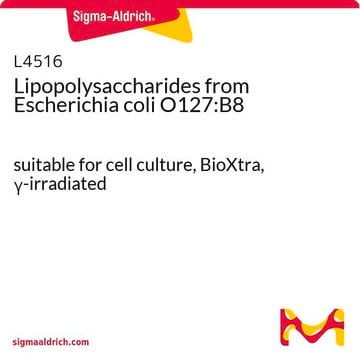L2630
Lipopolysaccharides from Escherichia coli O111:B4
purified by phenol extraction
Synonym(s):
LPS
About This Item
Recommended Products
biological source
Escherichia coli (O111:B4)
Quality Level
form
lyophilized powder
purified by
phenol extraction
technique(s)
ELISA: suitable
cell based assay: suitable
ligand binding assay: suitable
impurities
≤3.00% protein (Lowry-TCA)
color
off-white to faint yellow
solubility
water: soluble
application(s)
cell analysis
clinical research
life science and biopharma
shipped in
ambient
storage temp.
2-8°C
Looking for similar products? Visit Product Comparison Guide
General description
This product is phenol extracted from Escherichia coli serotype O111:B4. The source strain is from a private collection. This LPS serotype has been used to stimulate B-cells and induce NOS (nitric oxide synthase) in human hepatocytes.
Application
- for the stimulation of macrophages
- for LPS preconditioning in mice
- to induce acute kidney injury in mice
- to induce acute respiratory distress syndrome (ARDS) in mice to study the anti-inflammatory effects of bone marrow mesenchymal stem cell (BMSCs)-derived exosomes
- to induce hyperinflammatory status in severe acute respiratory syndrome coronavirus 2 (SARS-CoV-2) infected mice
Biochem/physiol Actions
Preparation Note
Other Notes
related product
Signal Word
Danger
Hazard Statements
Precautionary Statements
Hazard Classifications
Acute Tox. 2 Oral
Storage Class Code
6.1A - Combustible acute toxic Cat. 1 and 2 / very toxic hazardous materials
WGK
WGK 3
Flash Point(F)
Not applicable
Flash Point(C)
Not applicable
Personal Protective Equipment
Certificates of Analysis (COA)
Search for Certificates of Analysis (COA) by entering the products Lot/Batch Number. Lot and Batch Numbers can be found on a product’s label following the words ‘Lot’ or ‘Batch’.
Already Own This Product?
Find documentation for the products that you have recently purchased in the Document Library.
Customers Also Viewed
Articles
Explore the structure, function, and diverse applications of Lipopolysaccharides. Discover their role in bacteria, serological specificity, and research potential.
Explore the structure, function, and diverse applications of Lipopolysaccharides. Discover their role in bacteria, serological specificity, and research potential.
Explore the structure, function, and diverse applications of Lipopolysaccharides. Discover their role in bacteria, serological specificity, and research potential.
Explore the structure, function, and diverse applications of Lipopolysaccharides. Discover their role in bacteria, serological specificity, and research potential.
Our team of scientists has experience in all areas of research including Life Science, Material Science, Chemical Synthesis, Chromatography, Analytical and many others.
Contact Technical Service





